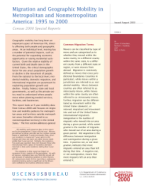
An official website of the United States government
Here’s how you know
Official websites use .gov
A .gov website belongs to an official government organization in the United States.
Secure .gov websites use HTTPS
A lock (
) or https:// means you’ve safely connected to the .gov website. Share sensitive information only on official, secure websites.
-
//
- Census.gov /
- Library /
- Publications /
- Migration and Geographic Mobility in America
Migration and Geographic Mobility in Metropolitan and Nonmetropolitan America: 1995 to 2000
Migration and Geographic Mobility in Metropolitan and Nonmetropolitan America: 1995 to 2000
Geographic mobility has long been an important aspect of American life, directly affecting both people and geographic areas. At an individual level, moving has a number of potential impacts, such as the potential for expanding economic opportunity or raising residential satisfaction. Given the relative stability of current birth and death rates in the United States, the critical demographic factor for any area’s population growth or decline is the movement of people. From the national to the local level, residential mobility, domestic migration, and international migration are paramount to explaining population growth and decline. Finally, federal, state and local governments, as well as the private sector, need to understand where people move when planning needed services, facilities, and businesses.
This report looks at 5-year mobility data from Census 2000 and focuses on migration and mobility patterns for metropolitan areas and territory outside metropolitan areas (hereafter referred to as nonmetropolitan territory) in the United States. The first section addresses general mobility patterns for those living in metropolitan areas within central cities, those living in metropolitan areas outside central cities, and those living in nonmetropolitan territory. Section two examines migration patterns for nonmetropolitan residents, and the third section looks at migration patterns to and from metropolitan areas by size, and for the twenty largest metropolitan areas (metropolitan statistical areas [MSAs] and consolidated metropolitan statistical areas [CMSAs]).
Others in Series
Publication
Publication
Publication
Share
Related Information
Some content on this site is available in several different electronic formats. Some of the files may require a plug-in or additional software to view.
 Yes
Yes
 No
NoComments or suggestions?


Top

